what causes a star to expand outwards quizlet

Past and future Milankovitch cycles via VSOP model
• Graphic shows variations in five orbital elements:
Axial tilt or obliquity (ε).
Eccentricity (e).
Longitude of perihelion ( sin(ϖ) ).
Precession index ( eastward sin(ϖ) )
• Precession index and obliquity command insolation at each latitude:
Daily-average insolation at peak of atmosphere on summertime solstice ( ) at 65° N
• Ocean sediment and Antarctic ice strata tape ancient ocean levels and temperatures:
Benthic forams (57 widespread locations)
Vostok ice core (Antarctica)
• Vertical gray line shows present (2000 CE)
Milankovitch cycles depict the collective furnishings of changes in the Earth's movements on its climate over thousands of years. The term is named for Serbian geophysicist and astronomer Milutin Milanković. In the 1920s, he hypothesized that variations in eccentricity, centric tilt, and precession combined to result in cyclical variations in the intra-almanac and latitudinal distribution of solar radiation at the Globe's surface, and that this orbital forcing strongly influenced the World's climatic patterns.[ citation needed ]
Similar astronomical hypotheses had been advanced in the 19th century by Joseph Adhemar, James Croll, and others, but verification was difficult because in that location was no reliably dated evidence, and because information technology was unclear which periods were important.[ citation needed ]
In recent years, materials on Earth that have been unchanged for millennia (obtained via ice, stone, and deep body of water cores) have been studied to indicate the history of Earth's climate. Although broadly consequent with the Milankovitch hypothesis, a number of specific observations are not explained by the hypothesis.[ citation needed ]
Globe's movements [edit]
The Earth's rotation around its axis, and revolution around the Dominicus, evolve over time due to gravitational interactions with other bodies in the Solar System. The variations are complex, only a few cycles are dominant.[one]
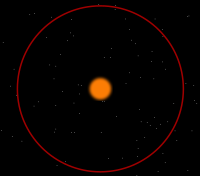
Circular orbit, no eccentricity

Orbit with 0.five eccentricity, exaggerated for illustration; World's orbit is only slightly eccentric
The World's orbit varies betwixt nearly circular and mildly elliptical (its eccentricity varies). When the orbit is more than elongated, in that location is more variation in the altitude between the Earth and the Sunday, and in the corporeality of solar radiations, at different times in the year. In addition, the rotational tilt of the Earth (its obliquity) changes slightly. A greater tilt makes the seasons more farthermost. Finally, the direction in the fixed stars pointed to by the Earth'south axis changes (axial precession), while the Earth'south elliptical orbit effectually the Sun rotates (apsidal precession). The combined effect of precession with eccentricity is that proximity to the Dominicus occurs during different astronomical seasons.[2]
Milankovitch studied changes in these movements of the World, which alter the amount and location of solar radiation reaching the Earth. This is known equally solar forcing (an example of radiative forcing). Milankovitch emphasized the changes experienced at 65° north due to the great corporeality of land at that latitude. Land masses alter temperature more rapidly than oceans, because of the mixing of surface and deep h2o and the fact that soil has a lower volumetric oestrus capacity than h2o.[3]
Orbital eccentricity [edit]
The Earth'south orbit approximates an ellipse. Eccentricity measures the departure of this ellipse from circularity. The shape of the Earth's orbit varies betwixt virtually round (with the lowest eccentricity of 0.000055) and mildly elliptical (highest eccentricity of 0.0679).[iv] Its geometric or logarithmic mean is 0.0019. The major component of these variations occurs with a period of 413,000 years (eccentricity variation of ±0.012). Other components have 95,000-year and 125,000-year cycles (with a beat menses of 400,000 years). They loosely combine into a 100,000-year cycle (variation of −0.03 to +0.02). The present eccentricity is 0.017 and decreasing.[ citation needed ]
Eccentricity varies primarily due to the gravitational pull of Jupiter and Saturn. The semi-major axis of the orbital ellipse, however, remains unchanged; co-ordinate to perturbation theory, which computes the evolution of the orbit, the semi-major axis is invariant. The orbital period (the length of a sidereal year) is besides invariant, considering according to Kepler's tertiary police force, it is determined past the semi-major axis.[ citation needed ]
Result on temperature [edit]
The semi-major centrality is a constant. Therefore, when World's orbit becomes more eccentric, the semi-modest axis shortens. This increases the magnitude of seasonal changes.[5]
The relative increase in solar irradiation at closest arroyo to the Dominicus (perihelion) compared to the irradiation at the furthest distance (aphelion) is slightly larger than four times the eccentricity. For Earth's current orbital eccentricity, incoming solar radiation varies by about 6.8%, while the distance from the Sunday currently varies by only three.4% (5.one meg km or 3.two million mi or 0.034 au).[ citation needed ]
Perihelion shortly occurs around January iii, while aphelion is around July 4. When the orbit is at its almost eccentric, the corporeality of solar radiation at perihelion will exist almost 23% more than at aphelion. Nevertheless, the Earth's eccentricity is always so small that the variation in solar irradiation is a minor cistron in seasonal climate variation, compared to axial tilt and even compared to the relative ease of heating the larger land masses of the northern hemisphere.[ commendation needed ]
Effect on lengths of seasons [edit]
| Year | Northern Hemisphere | Southern Hemisphere | Appointment: UTC | Season elapsing |
|---|---|---|---|---|
| 2005 | Winter solstice | Summer solstice | 21 December 2005 18:35 | 88.99 days |
| 2006 | Spring equinox | Autumn equinox | 20 March 2006 eighteen:26 | 92.75 days |
| 2006 | Summer solstice | Winter solstice | 21 June 2006 12:26 | 93.65 days |
| 2006 | Autumn equinox | Spring equinox | 23 September 2006 iv:03 | 89.85 days |
| 2006 | Winter solstice | Summer solstice | 22 Dec 2006 0:22 | 88.99 days |
| 2007 | Spring equinox | Fall equinox | 21 March 2007 0:07 | 92.75 days |
| 2007 | Summer solstice | Winter solstice | 21 June 2007 18:06 | 93.66 days |
| 2007 | Fall equinox | Jump equinox | 23 September 2007 nine:51 | 89.85 days |
| 2007 | Winter solstice | Summertime solstice | 22 December 2007 06:08 |
The seasons are quadrants of the Globe's orbit, marked by the 2 solstices and the two equinoxes. Kepler'south second law states that a body in orbit traces equal areas over equal times; its orbital velocity is highest effectually perihelion and lowest around aphelion. The Earth spends less time near perihelion and more time almost aphelion. This means that the lengths of the seasons vary.[vii] Perihelion currently occurs around January 3, and so the Earth's greater velocity shortens winter and autumn in the northern hemisphere. Summer in the northern hemisphere is 4.66 days longer than winter, and leap is 2.9 days longer than autumn.[7] Greater eccentricity increases the variation in the World'south orbital velocity. Currently, nonetheless, the Earth'south orbit is becoming less eccentric (more near circular). This will make the seasons in the firsthand future more similar in length.[7]
Axial tilt (obliquity) [edit]
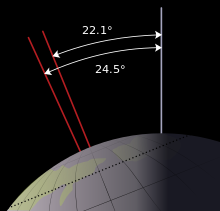
22.1–24.5° range of Earth'south obliquity.
The angle of the Earth's axial tilt with respect to the orbital plane (the obliquity of the ecliptic) varies between 22.one° and 24.5°, over a wheel of about 41,000 years. The electric current tilt is 23.44°, roughly halfway betwixt its extreme values. The tilt last reached its maximum in eight,700 BCE. It is now in the decreasing phase of its bike, and will reach its minimum around the yr 11,800 CE.[seven] Increased tilt increases the aamplitude of the seasonal cycle in insolation, providing more than solar radiation in each hemisphere's summer and less in winter. However, these effects are non uniform everywhere on the Earth's surface. Increased tilt increases the total annual solar radiation at college latitudes, and decreases the total closer to the equator.[7]
The current tendency of decreasing tilt, by itself, will promote milder seasons (warmer winters and colder summers), equally well as an overall cooling trend.[7] Because well-nigh of the planet'due south snowfall and ice lies at high breadth, decreasing tilt may encourage the termination of an interglacial period and the onset of a glacial period for two reasons: ane) in that location is less overall summer insolation, and, 2) there is less insolation at college latitudes (which melts less of the previous winter's snow and ice).[7]
Axial precession [edit]
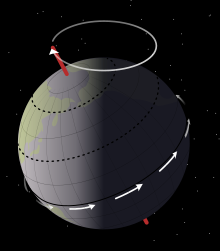
Axial precessional movement.
Axial precession is the tendency in the management of the Earth's axis of rotation relative to the fixed stars, with a period of 25,771.5 years. Likewise known equally the precession of the equinoxes, this motion means that eventually Polaris will no longer exist the due north pole star. This precession is caused by the tidal forces exerted by the Sun and the Moon on the rotating Earth; both contribute roughly equally to this consequence.
Currently, perihelion occurs during the southern hemisphere'southward summertime. This means that solar radiation due to both the axial tilt inclining the southern hemisphere toward the Sunday, and the Globe'southward proximity to the Sun, volition achieve maximum during the southern summer and accomplish minimum during the southern winter. These furnishings on heating are thus additive, which means that seasonal variation in irradiation of the southern hemisphere is more extreme. In the northern hemisphere, these ii factors reach maximum at opposite times of the year: the n is tilted toward the Sunday when the Earth is furthest from the Sun. The two effects work in opposite directions, resulting in less extreme variations in insolation.[ citation needed ]
In about 13,000 years, the north pole volition be tilted toward the Sun when the Earth is at perihelion.[ citation needed ] Axial tilt and orbital eccentricity will both contribute their maximum increment in solar radiation during the northern hemisphere'south summertime. Axial precession will promote more farthermost variation in irradiation of the northern hemisphere and less farthermost variation in the southward.[ commendation needed ] When the World's axis is aligned such that aphelion and perihelion occur near the equinoxes, axial tilt volition not be aligned with or against eccentricity.[ citation needed ]
Apsidal precession [edit]
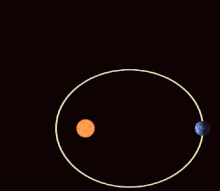
Planets orbiting the Lord's day follow elliptical (oval) orbits that rotate gradually over time (apsidal precession). The eccentricity of this ellipse, too as the rate of precession, are exaggerated for visualization.
The orbital ellipse itself precesses in space, in an irregular fashion, completing a full cycle every 112,000 years relative to the fixed stars.[viii] Apsidal precession occurs in the airplane of the ecliptic and alters the orientation of the Earth'southward orbit relative to the ecliptic. This happens primarily as a event of interactions with Jupiter and Saturn. Smaller contributions are also made by the sunday'southward oblateness and by the effects of general relativity that are well known for Mercury.[9]
Apsidal precession combines with the 25,771.v-year bicycle of axial precession (encounter in a higher place) to vary the position in the year that the Earth reaches perihelion. Apsidal precession shortens this period to 23,000 years on average (varying betwixt twenty,800 and 29,000 years).[8]
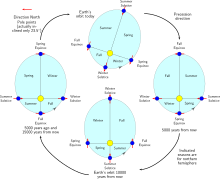
As the orientation of Globe'due south orbit changes, each season will gradually beginning earlier in the year. Precession ways the Earth's nonuniform movement (see above) will affect different seasons. Winter, for instance, will be in a different section of the orbit. When the Earth'southward apsides (extremes of altitude from the dominicus) are aligned with the equinoxes, the length of spring and summertime combined will equal that of autumn and winter. When they are aligned with the solstices, the difference in the length of these seasons will be greatest.[ commendation needed ]
Orbital inclination [edit]
The inclination of World'southward orbit drifts up and downwardly relative to its present orbit. This iii-dimensional motion is known as "precession of the ecliptic" or "planetary precession". Globe's electric current inclination relative to the changeless aeroplane (the plane that represents the angular momentum of the Solar System—approximately the orbital plane of Jupiter) is ane.57°.[ citation needed ] Milankovitch did non study planetary precession. It was discovered more recently and measured, relative to Globe'due south orbit, to accept a menstruum of virtually seventy,000 years. When measured independently of World's orbit, but relative to the invariable plane, even so, precession has a menstruation of well-nigh 100,000 years. This period is very similar to the 100,000-yr eccentricity period. Both periods closely match the 100,000-year pattern of glacial events.[10]
Theory constraints [edit]

Tabernas Desert, Espana: Cycles can be observed in the colouration and resistance of unlike sediment strata.
Materials taken from the Earth have been studied to infer the cycles of by climate. Antarctic ice cores comprise trapped air bubbling whose ratios of unlike oxygen isotopes are a reliable proxy for global temperatures around the time the ice was formed. Report of this data concluded that the climatic response documented in the water ice cores was driven by northern hemisphere insolation as proposed by the Milankovitch hypothesis.[11]
Analysis of deep-ocean cores and of lake depths,[12] [13] and a seminal paper by Hays, Imbrie, and Shackleton[14] provide boosted validation through physical bear witness. Climate records contained in a 1,700 ft (520 k) core of rock drilled in Arizona show a design synchronized with Earth'southward eccentricity, and cores drilled in New England match it, going back 215 meg years.[xv]
100,000-year issue [edit]
Of all the orbital cycles, Milankovitch believed that obliquity had the greatest effect on climate, and that it did so past varying the summertime insolation in northern high latitudes. Therefore, he deduced a 41,000-yr period for ice ages.[16] [17] However, subsequent enquiry[14] [18] [19] has shown that ice historic period cycles of the Fourth glaciation over the last million years have been at a period of 100,000 years, which matches the eccentricity cycle. Various explanations for this discrepancy accept been proposed, including frequency modulation[20] or various feedbacks (from carbon dioxide, cosmic rays, or from ice canvass dynamics). Some models can reproduce the 100,000-year cycles equally a issue of non-linear interactions between small changes in the Earth's orbit and internal oscillations of the climate arrangement.[21] [22]
Jung-Eun Lee of Brownish University proposes that precession changes the amount of energy that Earth absorbs, because the southern hemisphere'south greater ability to abound ocean water ice reflects more energy away from Earth. Moreover, Lee says, "Precession simply matters when eccentricity is large. That'south why we encounter a stronger 100,000-year stride than a 21,000-year footstep."[23] [24] Some others have argued that the length of the climate record is insufficient to establish a statistically meaning relationship between climate and eccentricity variations.[25]
Transition changes [edit]
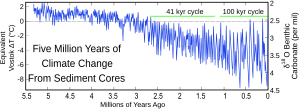
Variations of cycle times, curves determined from ocean sediments.

420,000 years of ice core data from Vostok, Antarctica enquiry station, with more recent times on the left.
From i–three one thousand thousand years ago, climate cycles matched the 41,000-twelvemonth cycle in obliquity. Later one one thousand thousand years ago, the Mid-Pleistocene Transition (MPT) occurred with a switch to the 100,000-year cycle matching eccentricity. The transition problem refers to the need to explain what changed one million years ago.[26] The MPT tin can at present be reproduced in numerical simulations that include a decreasing tendency in carbon dioxide and glacially induced removal of regolith.[27]
Interpretation of unsplit peak variances [edit]
Even the well-dated climate records of the last million years do not exactly match the shape of the eccentricity curve. Eccentricity has component cycles of 95,000 and 125,000 years. Some researchers, however, say the records do not show these peaks, but but signal a single cycle of 100,000 years.[28] The divide betwixt the two eccentricity components, withal, is observed at least once in a drill core from the 500 million years sometime Scandinavian Alum Shale.[29]
Unsynced stage five observation [edit]
Deep-sea cadre samples prove that the interglacial interval known as marine isotope stage 5 began 130,000 years agone. This is 10,000 years before the solar forcing that the Milankovitch hypothesis predicts. (This is also known as the causality problem, because the upshot precedes the putative cause.)[thirty]
Present and time to come conditions [edit]

By and time to come estimations of daily boilerplate insolation at top of the atmosphere on the twenty-four hours of the summer solstice, at 65° N latitude. The green curve is with eccentricity e hypothetically prepare to 0. The cherry-red bend uses the actual (predicted) value of e; the blue dot indicates current conditions (2000 CE).
Since orbital variations are anticipated,[31] any model that relates orbital variations to climate tin can be run forrard to predict future climate, with ii caveats: the mechanism past which orbital forcing influences climate is not definitive; and not-orbital effects tin be important (for example, the human being impact on the surround principally increases greenhouse gases resulting in a warmer climate[32] [33] [34]).
An oftentimes-cited 1980 orbital model by Imbrie predicted "the long-term cooling trend that began some 6,000 years ago will continue for the next 23,000 years."[35] More recent work suggests that orbital variations should gradually increase 65° N summer insolation over the next 25,000 years.[ failed verification ] [ failed verification ] World'southward orbit will become less eccentric for most the next 100,000 years, and so changes in this insolation will be dominated by changes in obliquity, and should non reject plenty to permit a new glacial period in the adjacent 50,000 years.[36] [37]
Other angelic bodies [edit]
Mars [edit]
Since 1972, speculation sought a relationship between the formation of Mars' alternating brilliant and dark layers in the polar layered deposits, and the planet's orbital climate forcing. In 2002, Laska, Levard, and Mustard showed water ice-layer radiance, as a function of depth, correlate with the insolation variations in summer at the Martian north pole, like to palaeoclimate variations on Earth. They also showed Mars' precession had a period of about 51 kyr, obliquity had a period of almost 120 kyr, and eccentricity had a menses ranging betwixt 95 and 99 kyr. In 2003, Caput, Mustard, Kreslavsky, Milliken, and Marchant proposed Mars was in an interglacial period for the past 400 kyr, and in a glacial period betwixt 400 and 2100 kyr, due to Mars' obliquity exceeding 30°. At this farthermost obliquity, insolation is dominated past the regular periodicity of Mars' obliquity variation.[38] [39] Fourier analysis of Mars' orbital elements, bear witness an obliquity period of 128 kyr, and a precession index catamenia of 73 kyr.[40] [41]
Mars has no moon large enough to stabilize its obliquity, which has varied from 10 to 70 degrees. This would explicate recent observations of its surface compared to show of unlike conditions in its past, such as the extent of its polar caps.[42] [43]
Outer Solar organisation [edit]
Saturn'south moon Titan has a cycle of approximately threescore,000 years that could modify the location of the marsh gas lakes.[44] Neptune's moon Triton has a variation similar to Titan's, which could cause its solid nitrogen deposits to migrate over long fourth dimension scales.[45]
Exoplanets [edit]
Scientists using computer models to report farthermost axial tilts have concluded that high obliquity could crusade extreme climate variations, and while that would probably not render a planet uninhabitable, information technology could pose difficulty for land-based life in affected areas. Almost such planets would withal allow development of both elementary and more complex lifeforms.[46] Although the obliquity they studied is more farthermost than Earth always experiences, in that location are scenarios 1.5 to 4.5 billion years from at present, as the Moon'southward stabilizing event lessens, where obliquity could go out its electric current range and the poles could eventually point nearly direct at the Sun.[47]
References [edit]
- ^ Girkin AM (2005). A Computational Study on the Evolution of the Dynamics of the Obliquity of the World (PDF) (Chief of Science thesis). Miami Academy. [ permanent dead link ]
- ^ G. K. Gilbert (February–March 1895). "Sedimentary Measurement of Cretaceous Time". The Journal of Geology. University of Chicago Press. 3 (ii): 121–127. Bibcode:1895JG......3..121G. doi:10.1086/607150. JSTOR 30054556. S2CID 129629329.
As the earth's axis slowly describes its circle on the celestial sphere the relation of the seasons to perihelion is steadily shifted.
Note: It is intuitive that if equinoxes and solstices occur in shifting positions on an eccentric orbit, so these astronomical seasons must occur at shifting proximities; and as either eccentricity and tilt vary, the intensities of the furnishings of these shifts besides vary. - ^ Abu-Hamdeh (2020). "Thermal Properties of Soils as afflicted by Density and Water Content". Biosystems Engineering., 01 Sep 2003, 86(1):97-102. 86 (1): 97–102. Retrieved 2021-05-16 .
Volumetric heat chapters ranged from ane.48 to 3.54 MJ/chiliad3/°C for dirt and from 1.09 to iii.04 MJ/m3/°C for sand at wet contents from 0 to 0·25 (kg/kg) [etc.]
[Note: Encounter Tabular array of specific heat capacities; water is about 4.ii MJ/m3/°C.] - ^ Laskar J, Fienga A, Gastineau Grand, Manche H (2011). "La2010: A New Orbital Solution for the Long-term Motion of the Earth" (PDF). Astronomy & Astrophysics. 532 (A889): A89. arXiv:1103.1084. Bibcode:2011A&A...532A..89L. doi:10.1051/0004-6361/201116836. S2CID 10990456.
- ^ Berger A, Loutre MF, Mélice JL (2006). "Equatorial insolation: from precession harmonics to eccentricity frequencies" (PDF). Clim. Past Discuss. 2 (iv): 519–533. doi:10.5194/cpd-2-519-2006.
- ^ Data from Usa Naval Observatory
- ^ a b c d east f g Alan Buis, NASA'southward Jet Propulsion Laboratory (Feb 27, 2020). "Milankovitch (Orbital) Cycles and Their Role in Earth's Climate". climate.nasa.gov. NASA. Retrieved May 10, 2021.
Over the terminal million years, information technology has varied between 22.1 and 24.five degrees. ... The greater World'south axial tilt angle, the more extreme our seasons are, .... Larger tilt angles favor periods of deglaciation (the melting and retreat of glaciers and ice sheets). These furnishings aren't compatible globally -- higher latitudes receive a larger change in total solar radiation than areas closer to the equator. ... Earth's centrality is currently tilted 23.iv degrees, .... As ice encompass increases, information technology reflects more of the Sunday's energy back into space, promoting even further cooling.
Note: See Axial tilt. Zilch obliquity results in minimum (zero) continuous insolation at the poles and maximum continuous insolation at the equator. Any increase of obliquity (to 90 degrees) causes seasonal increase of insolation at the poles and causes decrease of insolation at the equator on any day of the year except an Equinox. - ^ a b van den Heuvel EP (1966). "On the Precession as a Crusade of Pleistocene Variations of the Atlantic Ocean H2o Temperatures". Geophysical Journal International. 11 (iii): 323–336. Bibcode:1966GeoJ...xi..323V. doi:10.1111/j.1365-246X.1966.tb03086.x.
- ^ Barbieri, L; Talamucci, F (20 February 2018). "Calculation of apsidal precession via perturbation theory". arXiv:1802.07115 [physics.class-ph].
- ^ Muller RA, MacDonald GJ (Baronial 1997). "Spectrum of 100-kyr glacial wheel: orbital inclination, non eccentricity". Proceedings of the National Academy of Sciences of the United states. 94 (16): 8329–34. Bibcode:1997PNAS...94.8329M. doi:10.1073/pnas.94.16.8329. PMC33747. PMID 11607741.
- ^ Kawamura M, Parrenin F, Lisiecki 50, Uemura R, Vimeux F, Severinghaus JP, et al. (August 2007). "Northern Hemisphere forcing of climatic cycles in Antarctica over the past 360,000 years". Nature. 448 (7156): 912–6. Bibcode:2007Natur.448..912K. doi:x.1038/nature06015. PMID 17713531. S2CID 1784780.
- ^ Kerr RA (February 1987). "Milankovitch Climate Cycles Through the Ages: Earth'south orbital variations that bring on ice ages have been modulating climate for hundreds of millions of years". Science. 235 (4792): 973–4. Bibcode:1987Sci...235..973K. doi:ten.1126/science.235.4792.973. JSTOR 1698758. PMID 17782244. /O
- ^ Olsen PE (November 1986). "A 40-million-year lake tape of early mesozoic orbital climatic forcing". Scientific discipline. 234 (4778): 842–8. Bibcode:1986Sci...234..842O. doi:10.1126/science.234.4778.842. JSTOR 1698087. PMID 17758107. S2CID 37659044.
- ^ a b Hays JD, Imbrie J, Shackleton NJ (Dec 1976). "Variations in the Earth's Orbit: Pacemaker of the Water ice Ages". Science. 194 (4270): 1121–32. Bibcode:1976Sci...194.1121H. doi:10.1126/scientific discipline.194.4270.1121. PMID 17790893. S2CID 667291.
- ^ Bakalar N (2018-05-21). "Every 202,500 Years, Globe Wanders in a New Direction". New York Times . Retrieved 2018-05-25 .
- ^ Milankovitch M (1998) [1941]. Canon of Insolation and the Ice Historic period Problem. Belgrade: Zavod za Udz̆benike i Nastavna Sredstva. ISBN978-86-17-06619-0. ; encounter also "Astronomical Theory of Climatic change".
- ^ Imbrie J, Imbrie KP (1986). Ice Ages: Solving the Mystery. Harvard University Printing. p. 158. ISBN978-0-674-44075-iii.
- ^ Shackleton NJ, Berger A, Peltier WR (3 November 2011). "An culling astronomical calibration of the lower Pleistocene timescale based on ODP Site 677". Transactions of the Imperial Society of Edinburgh: Globe Sciences. 81 (four): 251–261. doi:x.1017/S0263593300020782.
- ^ Abe-Ouchi A, Saito F, Kawamura Chiliad, Raymo ME, Okuno J, Takahashi K, Blatter H (August 2013). "Insolation-driven 100,000-year glacial cycles and hysteresis of ice-sheet book". Nature. 500 (7461): 190–3. Bibcode:2013Natur.500..190A. doi:10.1038/nature12374. PMID 23925242. S2CID 4408240.
- ^ Rial JA (October 2003), "Earth's orbital Eccentricity and the rhythm of the Pleistocene ice ages: the concealed pacemaker" (PDF), Global and Planetary Change, 41 (2): 81–93, Bibcode:2004GPC....41...81R, doi:10.1016/j.gloplacha.2003.10.003, archived from the original (PDF) on 2011-07-xx
- ^ Ghil M (1994). "Cryothermodynamics: the cluttered dynamics of paleoclimate". Physica D. 77 (1–three): 130–159. Bibcode:1994PhyD...77..130G. doi:10.1016/0167-2789(94)90131-seven.
- ^ Gildor H, Tziperman E (2000). "Sea water ice equally the glacial cycles' climate switch: Role of seasonal and orbital forcing". Paleoceanography. 15 (6): 605–615. Bibcode:2000PalOc..xv..605G. doi:10.1029/1999PA000461.
- ^ Stacey 1000 (2017-01-26). "Globe'due south orbital variations and bounding main ice synch glacial periods". m.phys.org.
- ^ Lee JE, Shen A, Fox-Kemper B, Ming Y (1 Jan 2017). "Hemispheric sea ice distribution sets the glacial tempo". Geophys. Res. Lett. 44 (two): 1008–1014. Bibcode:2017GeoRL..44.1008L. doi:10.1002/2016GL071307.
- ^ Wunsch C (2004). "Quantitative gauge of the Milankovitch-forced contribution to observed Quaternary climate change". Fourth Scientific discipline Reviews. 23 (9–10): 1001–12. Bibcode:2004QSRv...23.1001W. doi:10.1016/j.quascirev.2004.02.014.
- ^ Zachos JC, Shackleton NJ, Revenaugh JS, Pälike H, Blossom BP (April 2001). "Climate response to orbital forcing across the Oligocene-Miocene boundary". Science. 292 (5515): 274–8. Bibcode:2001Sci...292..274Z. doi:ten.1126/scientific discipline.1058288. PMID 11303100. S2CID 38231747. Archived from the original on 2017-12-03. Retrieved 2010-x-24 .
- ^ Willeit One thousand, Ganopolski A, Calov R, Brovkin V (April 2019). "Mid-Pleistocene transition in glacial cycles explained by declining CO2 and regolith removal". Science Advances. 5 (4): eaav7337. Bibcode:2019SciA....5.7337W. doi:10.1126/sciadv.aav7337. PMC6447376. PMID 30949580.
- ^ "Nonlinear coupling between 100 ka periodicity of the paleoclimate records in loess and periodicities of precession and semi-precession" (PDF) – via ProQuest.
- ^ Sørensen, A.L., Nielsen, A.T., Thibault, N., Zhao, Z., Schovsbo, N.H., Dahl, T.W., 2020. Astronomically forced climate change in the late Cambrian. Earth Planet. Sci. Lett. 548, 116475. https://doi.org/x.1016/j.epsl.2020.116475
- ^ Karner DB, Muller RA (June 2000). "PALEOCLIMATE: A Causality Problem for Milankovitch". Science. 288 (5474): 2143–four. doi:10.1126/science.288.5474.2143. PMID 17758906. S2CID 9873679.
- ^ Varadi F, Runnegar B, Ghil M (2003). "Successive Refinements in Long-Term Integrations of Planetary Orbits". The Astrophysical Journal. 592 (1): 620–630. Bibcode:2003ApJ...592..620V. doi:10.1086/375560.
- ^ Kaufman DS, Schneider DP, McKay NP, Ammann CM, Bradley RS, Briffa KR, et al. (September 2009). "Recent warming reverses long-term arctic cooling". Science. 325 (5945): 1236–9. Bibcode:2009Sci...325.1236K. CiteSeerX10.1.1.397.8778. doi:ten.1126/science.1173983. PMID 19729653. S2CID 23844037.
- ^ "Arctic Warming Overtakes two,000 Years of Natural Cooling". UCAR. September iii, 2009. Archived from the original on 27 April 2011. Retrieved 19 May 2011.
- ^ Bello D (September four, 2009). "Global Warming Reverses Long-Term Arctic Cooling". Scientific American. Retrieved 19 May 2011.
- ^ Imbrie J, Imbrie JZ (February 1980). "Modeling the climatic response to orbital variations". Science. 207 (4434): 943–53. Bibcode:1980Sci...207..943I. doi:10.1126/scientific discipline.207.4434.943. PMID 17830447. S2CID 7317540.
- ^ Berger A, Loutre MF (Baronial 2002). "Climate. An exceptionally long interglacial ahead?". Science. 297 (5585): 1287–8. doi:10.1126/science.1076120. PMID 12193773. S2CID 128923481.
- ^ Ganopolski A, Winkelmann R, Schellnhuber HJ (Jan 2016). "Disquisitional insolation-CO2 relation for diagnosing by and futurity glacial inception". Nature. 529 (7585): 200–3. Bibcode:2016Natur.529..200G. doi:10.1038/nature16494. PMID 26762457. S2CID 4466220.
- ^ Laskar J, Levrard B, Mustard JF (September 2002). "Orbital forcing of the martian polar layered deposits" (PDF). Nature. 419 (6905): 375–7. Bibcode:2002Natur.419..375L. doi:10.1038/nature01066. PMID 12353029. S2CID 4380705. Archived from the original (PDF) on 2011-07-nineteen. Retrieved 2020-12-11 .
- ^ Head JW, Mustard JF, Kreslavsky MA, Milliken RE, Marchant DR (Dec 2003). "Contempo ice ages on Mars" (PDF). Nature. 426 (6968): 797–802. Bibcode:2003Natur.426..797H. doi:10.1038/nature02114. PMID 14685228. S2CID 2355534.
- ^ Brzostowski M (2004). "Martian Milankovic Cycles, a Constraint for Understanding Martian Geology?". Western Pacific Geophysics Coming together, Supplement to Eos, Transactions, American Geophysical Union. 85 (28): WP11.
- ^ Brzostowski M (2020). "Milankovic Cycles on Mars and the Affect on Economic Exploration". ACE 2020. American Association of Petroleum Geologists. Retrieved 11 December 2020.
- ^ Schorghofer N (2008). "Temperature response of Mars to Milankovitch cycles". Geophysical Enquiry Messages. 35 (eighteen): L18201. Bibcode:2008GeoRL..3518201S. doi:10.1029/2008GL034954. S2CID 16598911.
- ^ "3.5 Modeling Milankovitch cycles on Mars (2010 – ninety; Almanac Symp Planet Atmos)". Confex.
- ^ Wethington, Nicholos (30 November 2009). "Lake Asymmetry on Titan Explained".
- ^ "Dominicus Blamed for Warming of World and Other Worlds". LiveScience.com. 12 March 2007.
- ^ Williams DM, Pollard P (2002). "Earth-like worlds on eccentric orbits: excursions across the habitable zone" (PDF). Inter. J. Astrobio. one (1): 21–9. Bibcode:2002IJAsB...one...61W. doi:x.1017/s1473550402001064. S2CID 37593615. Archived from the original (PDF) on 2013-08-22. Retrieved 2009-09-17 .
- ^ Neron de Surgy O, Laskar J (February 1997). "On the long term development of the spin of the Earth". Astronomy and Astrophysics. 318: 975–989. Bibcode:1997A&A...318..975N.
Bibliography [edit]
- The oldest reference for Milankovitch cycles is: Milankovitch M (1930). Mathematische Klimalehre und Astronomische Theorie der Klimaschwankungen. Handbuch der Klimatologie. Vol. ane Teil A. von Gebrüder Borntraeger. OCLC 490063906.
- Roe G (2006). "In defense of Milankovitch". Geophysical Research Letters. 33 (24): L24703. Bibcode:2006GeoRL..3324703R. doi:10.1029/2006GL027817. S2CID 13230658. This shows that Milankovitch theory fits the information extremely well, over the by million years, provided that we consider derivatives.
- Kaufmann RK, Juselius K (2016). "Testing competing forms of the Milankovitch hypothesis". Paleoceanography. 31 (2): 286–297. Bibcode:2016PalOc..31..286K. doi:10.1002/2014PA002767. .
- Edvardsson Southward, Karlsson KG, Engholm M (2002). "Accurate spin axes and solar system dynamics: Climatic variations for the Earth and Mars". Astronomy and Astrophysics. 384 (2): 689–701. Bibcode:2002A&A...384..689E. doi:ten.1051/0004-6361:20020029. This is the offset work that investigated the derivative of the ice volume in relation to insolation (page 698).
- Zachos J, Pagani G, Sloan L, Thomas E, Billups Chiliad (April 2001). "Trends, rhythms, and aberrations in global climate 65 Ma to present". Science. 292 (5517): 686–93. Bibcode:2001Sci...292..686Z. doi:10.1126/science.1059412. PMID 11326091. S2CID 2365991.
This review commodity discusses cycles and cracking-scale changes in the global climate during the Cenozoic Era. - Pälike H, Norris RD, Herrle JO, Wilson PA, Coxall HK, Lear CH, et al. (December 2006). "The heartbeat of the Oligocene climate arrangement" (PDF). Science. 314 (5807): 1894–viii. Bibcode:2006Sci...314.1894P. doi:10.1126/science.1133822. PMID 17185595. S2CID 32334205.
A thirteen-million-year continuous record of Oligocene climate from the equatorial Pacific reveals a pronounced "heartbeat" in the global carbon wheel and periodicity of glaciations.
- In Aboriginal Rocks Scientists Come across a Climate Cycle Working Across Deep Fourth dimension (Columbia Climate Schoolhouse, Kevin Krajick, May 7, 2018)
- Tying celastial mechanics to Earth's ice age (Physics Today 73 (v), Maslin Yard. A. 01 May 2020)
External links [edit]
![]() Media related to Milankovitch cycles at Wikimedia Commons
Media related to Milankovitch cycles at Wikimedia Commons
![]() Milankovitch cycles at Wikibooks
Milankovitch cycles at Wikibooks
- Ice Age – Milankovitch Cycles – National Geographic Channel
- The Milankovitch band, Internet Archive of American Geophysical Union lecture
- Campisano, C. J. (2012) Milankovitch Cycles, Paleoclimatic Change, and Hominin Development. Nature Education Knowledge 4(3):five
Source: https://en.wikipedia.org/wiki/Milankovitch_cycles

0 Response to "what causes a star to expand outwards quizlet"
Post a Comment